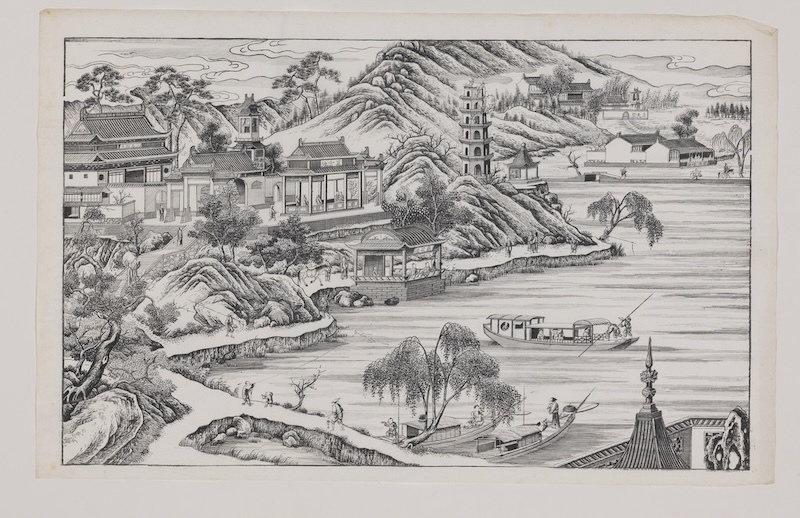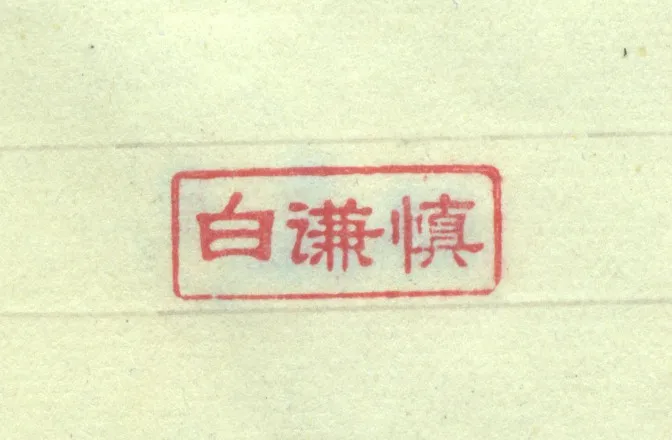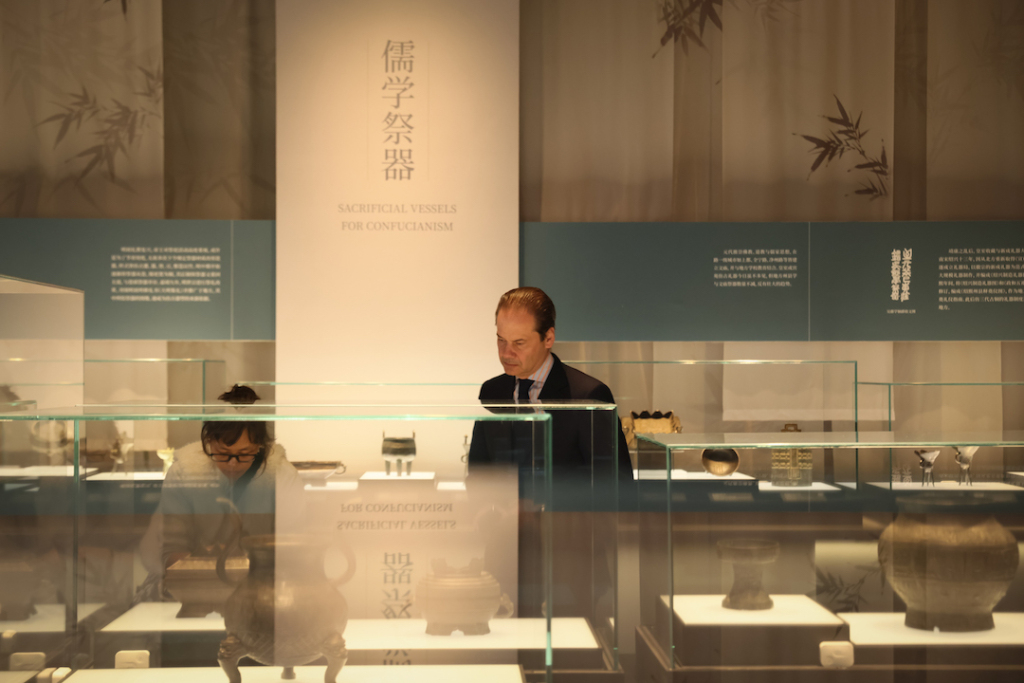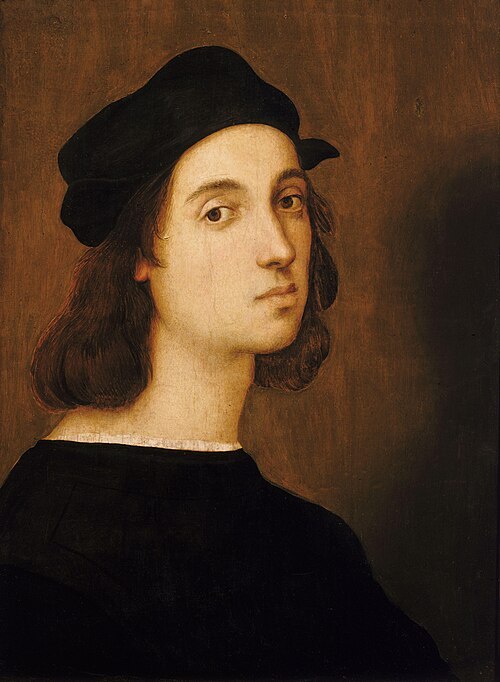
The Cleveland Museum of Art and the Metropolitan Museum of Art in New York recently announced a joint acquisition of 220 exquisitely crafted 18th-century Chinese woodblock prints from Gusu (Suzhou). As renowned museums with extensive holdings in Chinese painting, each acquiring over 100 Gusu prints makes them leading institutions in the world for the study of Gusu prints, demonstrating the international academic community's high recognition and admiration for the artistic value of Gusu prints. Ms. Haiyao Zheng (Katie), Director of the UK Woodblock Education Trust, recently interviewed Dr. Clarissa von Spee, the principal organizer of this acquisition.
This collection of Suzhou prints belongs to the renowned collector Christer von der Burg, the product of over forty years of meticulous collecting. A Swedish national, Christer von der Burg is the founder and chairman of the London-based Woodblock Education Trust (formerly the European Woodblock Foundation). Christer von der Burg is a registered non-profit organization dedicated to the research, collection, and promotion of Chinese woodblock prints. Christer von der Burg's collection of Suzhou prints is unrivaled among private collectors worldwide in terms of quantity, variety, and quality.
“We are delighted to be working with our colleagues at the Metropolitan Museum of Art on this unique acquisition, which provides both institutions with the opportunity to present these exceptional prints to American audiences within the context of their respective Chinese art collections,” said William M. Griswold, Director of the Cleveland Museum of Art. Dr. Clarissa von Spee, the James and Donna Reid Curator of Chinese Art, Interim Curator of Islamic Art, and Director of the Department of Asian Art, who spearheaded the acquisition, said: “This acquisition has transformative significance for the Cleveland Museum of Art. These prints allow us to showcase the invention of printing in China—centuries before Gutenberg’s European printing—and highlight the innovation of multi-color printing. The Suzhou prints are a powerful addition to our collection of Chinese paintings.”

West Lake Panorama 1, 38x59cm, Collection of the Cleveland Museum of Art

West Lake Panorama No. 2, 38x59cm, Collection of the Cleveland Museum of Art
Max Hollein, Director and CEO of the Metropolitan Museum of Art, also said, "These vivid works blend iconographic elements from China's elite painting traditions with folk art, and incorporate the techniques of European printmaking. They demonstrate an ongoing dialogue between different peoples and societies, and provide a rare opportunity to gain a deeper understanding of the international nature of Chinese visual culture." Joseph Scheier-Dolberg, the Tang Yuqian and Xu Xinmei Curator of Chinese Painting at the Metropolitan Museum of Art, said, "Suzhou prints embody the vitality of cross-cultural exchange in the early modern world. These 18th-century artworks, unrestrictedly absorbing both local and foreign visual traditions, were popular not only in China but also in Japan and Europe. As a result, Suzhou prints provide us with some of the most vivid historical evidence we have, demonstrating the close connections across human history."

Dr. Ming-Li Shih, Photo by Steve Zhao
Dialogue|Shi Mingli
About the acquisition process
Katie: First, congratulations to the Cleveland Clinic and the Metropolitan Museum of Art on their successful acquisition of 220 18th-century Suzhou prints from the collection of Mr. Feng Debao. I know you've known Mr. Feng for a long time and have been following his collection. Could you please describe the process of this significant acquisition?
Shi Mingli: I met Mr. Feng Debao when I was the curator of Chinese art at the British Museum in London. In 2010, I curated the exhibition "The Printed Image in China from the 8th to the 21st Centuries" at the British Museum, and Mr. Feng loaned us works. Later, when I worked at the Cleveland Museum of Art and curated "China's Southern Paradise - Treasures from the Lower Yangzi Delta" in 2024, Mr. Feng also provided collections for that exhibition. We've stayed in touch over the years and have become friends.
For over a decade, I've been following Mr. Feng's collecting and interacting with him frequently. So, when he decided to sell his Suzhou print collection, as the Cleveland Museum of Art's curator of Chinese art, I immediately expressed my interest, and the museum was very supportive. While this collection is quite significant, convincing the museum of such a significant investment took time, as the museum had never before systematically acquired Chinese prints as a genre.

Mr. Feng Debao and Dr. Shi Mingli

Mr. Feng Debao and Dr. Shi Mingli
Katie: The Cleveland Museum of Art and the Metropolitan Museum of Art jointly made this acquisition. How did you collaborate? Also, is it common for two institutions to jointly acquire and share the same collection?
Shi Mingli: This collection, comprising 220 Suzhou prints, is of great art historical significance, but also carries a high price tag. We felt that this acquisition would be best undertaken jointly by two institutions, while also wanting to preserve the integrity of Mr. Feng's collection. So, I approached the Metropolitan Museum of Art, and they proved to be a perfect partner. Mike Hearn, Director of the Met's Department of Asian Art, had previously brought my London exhibition "Chinese Prints" to the Met in 2012, presenting it to the American public. This time, Shi Yaohua, the Met's Curator of Chinese Painting, immediately endorsed my proposal. Both of them, along with the Met's director, recognized the significance of this collection of Suzhou prints.
The reasons for collaborating with the Met are multifaceted. Both the Cleveland Clinic and the Metropolitan Museum of Art possess world-class, encyclopedic collections. Both institutions are ideally situated to preserve these prints, and we share a commitment to serving the public through open access to our collections, allowing everyone to view and study them in person and through digital services available to millions of users worldwide. Both museums have Chinese calligraphy and painting restoration and conservation studios, which can ensure the long-term preservation of these Suzhou prints and set a museum-level standard for print conservation internationally.
It's also worth noting that both our institutions have dedicated curator and restorer positions in the field of Asian art, which is quite rare. In other words, both museums have curator and restorer positions for Chinese calligraphy and painting established with dedicated endowments. These positions are permanent and can never be rescinded, which is why both Shi Yaohua's and my titles have prefixes. This is particularly important for ensuring the long-term preservation and exhibition of this batch of Suzhou prints. Few other museums have this kind of situation.
Furthermore, both our museums are among the world's foremost lending institutions. In short, the Cleveland and Metropolitan Museums of Art offer ideal conditions for the preservation, continuation, and development of Mr. Feng's collection of Suzhou woodblock prints, including exhibitions, scholarly research, and publications. Because these prints are extremely sensitive to light, our galleries regularly rotate these exquisite works, continually presenting them to the public in diverse contexts and exhibition formats.

West Lake Panorama No. 3, 38x59cm, Collection of the Cleveland Museum of Art

West Lake Panorama, No. 4, 38x59cm, Collection of the Cleveland Museum of Art
Katie: So, how do you and your two institutions distribute these prints? Are there works that both institutions would like to acquire? Have there been any disputes? Will there be any exchange of works in the future?
Shi Mingli: The task of equitably distributing these works between the two museums falls to me, as I am most familiar with this collection of prints. Dividing these exquisite prints, which are so diverse in style, into two groups is not an easy task. Criteria to consider include form and size, the workshop that produced them, their condition, subject matter, and value, while also maintaining the integrity of the entire set. I will initially divide the prints into two groups, and then the Met can prioritize which group to receive, and I hope I won't regret their choice. Of course, the two groups may not be truly balanced. In fact, it would be almost impossible to achieve! Of course, there are many prints that both museums would very much like to acquire, such as the Met's set of four Suzhou literati beauties, the Cleveland Museum's "West Lake Panorama," and Ding Liangxian's exquisite "Birds on Pomegranate Blossoms." I don't foresee any future exchanges of prints, as each work has already been registered in the collections of both museums. But I am certain that we will loan prints to each other in the future.

Ding Liangxian, Birds on Pomegranate Flowers, 30x37cm, Cleveland Museum of Art
About Suzhou Woodblock Prints
Katie: Could you please tell us about Suzhou woodblock prints? Why are they so important? How do they relate to the Chinese woodblock print tradition?
Shi Mingli: As far as we know, woodblock printing was invented in China around the 7th century AD. The multi-color woodcut watermarking technique was developed in the early 17th century, and it took many years for this technique to reach maturity before it spread to Japan. In the 17th century, the printing industry flourished in many cities along the Jiangnan region, such as Nanjing, Suzhou, Hangzhou, and Huizhou. Initially, the printing industry produced color illustrated books for private collection and appreciation, and later evolved into more commercial single-sheet woodcut prints. These prints were taped or hung on walls, becoming part of the city's visual culture.
Classic works of early color woodblock prints include the "Ten Bamboo Studio Calligraphy and Painting Album" (circa 1633), the "Ten Bamboo Studio Paper Album" (circa 1644), and the "Mustard Seed Garden Painting Manual" (circa 1679 and 1701), all produced with the participation of Nanjing literati. These classic painting albums exist in multiple editions and are well-known. These works quickly spread to Korea and Japan. The peak of color woodblock prints was the numerous single-sheet prints produced by the Ding family workshop in Suzhou between 1720 and 1760. The works we acquired are all prints produced in Suzhou in the 18th century, also known as the "Gusu" edition, and they represent the highest achievement of color printmaking in the history of Chinese printmaking.

Suzhou Scholars - Qin, 107x57cm, Collection of the Metropolitan Museum of Art
It's also worth noting that the Ding workshop's prints of flowers, birds, fruits, and antiques utilize the architrave technique, a form of relief printing that creates a distinct three-dimensional effect and enhances the visual impression. While this technique is known to have been used in the Ten Bamboo Studio Paper Album, it's even more pronounced and prominent in Ding's prints. Even after more than three hundred years, we can still see this sculpted quality on the paper! I understand that this technique and style soon appeared in the work of the Japanese printmaker Suzuki Harunobu (circa 1725–1770), renowned for its gorgeous effects, elegant style, and refined use of color.
Katie: Most of these prints have survived overseas, some preserved by Europeans as interior wall decorations, others passed down through the hands of Japanese collectors. Very few remain in China. I know Mr. Feng has spent many years searching for these prints, and his collection has many interesting anecdotes.
Shi Mingli: Mr. Feng Debao was a pioneer in collecting Suzhou woodblock prints. After more than forty years of collecting and accumulating knowledge, he ultimately became the world's largest and most comprehensive private collector of Suzhou woodblock prints. As far as we know, these 18th-century Suzhou woodblock prints are virtually nonexistent in China, and American institutions have only sporadically acquired them. Mr. Feng Debao discovered and acquired these individual prints from private collections, family collections, manor houses, and auction houses in Europe and Japan. When he began collecting, Suzhou woodblock prints were largely unstudied and neglected. Mr. Feng Debao dedicated his life to finding, studying, and interpreting the prints, sharing his findings with researchers and scholars worldwide, which gradually attracted the attention of curators and experts.
As for an interesting collection story, I remember Mr. Feng once telling me about finding a Suzhou print hidden inside the lid of a wooden box used by a Swedish sailor. The sailor likely purchased the print in China and affixed it to the lid of the box, which then sailed across the ocean to Sweden. To obtain the print, Mr. Feng bought the box itself!

Suzhou Scholars - Chess, 107x57cm, Collection of the Metropolitan Museum of Art
Katie: Many of the pieces in this collection are quite large, measuring approximately 100 x 50 centimeters. Most are in color, some using the multi-color woodblock printing technique, while others are black and white prints then hand-painted. The subject matter is also diverse and rich. Would it be fair to say that Mr. Feng's collection is quite comprehensive?
Shi Mingli: Mr. Feng Debao's collection encompasses every type, format, and subject matter of 18th-century color prints, enabling the Cleveland and Metropolitan Museums of Art to present a comprehensive overview of this art form to the public. Many prints emulate the forms and techniques of more expensive paintings, including inscribed poems and signatures. The subjects of these prints are diverse, including antique artifacts, architectural landscapes, gardens, cityscapes, landscapes, ladies of noble birth, birds and flowers, games, and illustrations for operas, novels, and poems. Although prints could be produced in large quantities, their low price often led to their abandonment once they faded or damaged, resulting in a small number of surviving prints. Some of the pieces in this collection are large, while others are mounted as hanging scrolls. The flower and bird prints from the Ding workshop are mostly album-sized, and some are unique in existence, such as "Beauty of Suzhou: Mother and Child by the Summer Pavilion," a painting in the Cleveland Museum, which is the only surviving example.

"Suzhou Beauty - Mother and Child by the Summer Pavilion", 107x57cm, Collection of the Cleveland Museum of Art
Katie: These prints were very popular back then, and a large number must have been produced. However, almost no copies remain in China, which is hard to understand. What do you think is the reason?
Shi Mingli: As far as we know, Suzhou prints were not exported. Their primary target audience was wealthy families in Jiangnan cities. Prints were consumable items. After purchase, they were often pasted or hung on walls, given as gifts, or purchased as souvenirs. As I mentioned earlier, because they were mass-produced and inexpensive, they were discarded or replaced once they faded or damaged. China has a long tradition of collecting prints and treating them as works of art, which may be the main reason why Suzhou prints did not survive domestically in the 18th century. We don't fully understand how European and Japanese travelers and merchants acquired these prints. However, the fact that these prints survived as wall decorations in European castles and palaces proves that they did reach Europe. However, we don't know how they reached overseas markets. Some were also collected, preserved, and even copied by Japanese people, significantly influencing Japanese printmaking.

Suzhou Scholars - Books, 107x57cm, Collection of the Metropolitan Museum of Art
Katie: Another unique aspect of these prints is their extensive use of European visual techniques, employing intersecting perspective and line arrangement to depict light, shadow, and volume. European painting had been introduced to China centuries earlier, but its influence was primarily confined to the imperial court. It could be argued that with the rise of Suzhou printmaking, Western painting techniques were also accessible to middle- and upper-class families, demonstrating a highly internationalized visual culture at the time.
Shi Mingli: The artisans of Suzhou and its workshops had close ties and exchanges with officials and court painters in Beijing, as well as missionaries and Christians. Jesuits and other foreigners would often introduce new trends and novelties to the Beijing court, which would quickly spread and be adopted and used by printmakers in the south.
These new artistic techniques included line shading, a technique derived from European copperplate engraving, and intersecting perspective, which can be seen in figures, architecture, landscapes, and cityscapes. Eighteenth-century Suzhou set the pace not only in urban fashion but also in craftsmanship, spreading these new techniques throughout China.
Katie: Did the tradition of Suzhou woodblock prints continue into the 19th and 20th centuries?
Shi Mingli: Nineteenth-century China remained vibrant with creativity, but the Opium War severely impacted people's lives and their demand for luxury goods. Printmaking workshops were particularly hard hit in Jiangnan port cities like Zhenjiang, Nanjing, Shanghai, and Ningbo. The subsequent Taiping Rebellion devastated the entire southeast region, and consumer and commercial demand plummeted in the second half of the 19th century. The 20th century saw a resurgence of the printing industry, particularly in Shanghai and Beijing, ushering in a new chapter in the history of Chinese printmaking.

Suzhou Scholars - Painting, 107x57cm, Collection of the Metropolitan Museum of Art
About the Cleveland Museum of Art and the Woodblock Educational Trust
Katie: Can you tell us about the Cleveland Museum of Art and its collection of Chinese art?
Ming-Li Shi: The Cleveland Museum of Art is renowned for the quality and encyclopedic breadth of its collection, spanning six thousand years of artistic achievement. It serves as a leading platform for international exhibitions, scholarship, and the performing arts, and is a leader in digital innovation. As one of the nation's leading comprehensive art museums, it remains free and open to the public, with a mission to "benefit all people forever." Founded in 1913 and officially opened in 1916, the museum was built thanks to bequests from Cleveland industrialists Hinman B. Hurlbut, John Huntington, and Horace Kelley, who donated funds for the museum's construction; and Jeptha H. Wade II, who donated Wade Park as its site.
Three significant milestones occurred in 1958: a major expansion doubled the museum's size; a substantial bequest from Leonard Hanna Jr., which provided funds to expand the museum's collection of both domestic and international art; and the appointment of Sherman E. Lee as the museum's third director, renowned for his long tenure and his dedication to the development of the Asian collection, which has become one of the finest in the United States. Today, the museum's Chinese holdings are particularly strong in Buddhist sculpture, ancient paintings and calligraphy, porcelain, and textiles.
Katie: Suzhou prints have many imitations of paintings, but they are different from paintings. Their narrative, details of characters and architecture are all excellent, which will undoubtedly bring new perspectives to the study and collection of Chinese paintings. Collecting this batch of prints can be said to be a great supplement to the collection of paintings, right?
Shi Mingli: Yes, the acquisition of these prints establishes the Cleveland Museum as one of the world's leading institutions for the study of Suzhou prints. These new prints, closely related to and often imitating paintings, will bring new light, renewed attention, and a more comprehensive understanding to our outstanding collection of Chinese paintings. Furthermore, these works enable the Museum to showcase China's invention of printing, which long predates Gutenberg's movable type in Germany. This acquisition also highlights China's development of color printing, two inventions of great significance to global history.

Ding Liangxian, Magpie, 37.6x27.6cm, from the collection of the Metropolitan Museum of Art
Katie: Could you please tell us about the exhibition and publication plans for this group of works?
Shi Mingli: The museum plans to host the exhibition "Print Revolutions. Chinese impressions, 1630s–1960s" (tentative title) from November 2026 to May 2027. The exhibition will span three galleries, showcasing over sixty prints and accompanies an international conference. The exhibition will also coincide with the Cleveland Museum of Art's Print Fair in April 2027. Organized annually in the museum's spacious atrium by the Cleveland Print Society, founded in 1919, the fair brings together print galleries from across the United States. The museum also plans to host printmaking demonstrations and a public lecture by Mr. Feng. This exhibition will not only celebrate the museum's new acquisition but also mark the 30th anniversary of the European Woodblock Foundation (now the Woodblock Education Trust), founded by Mr. Feng in London.
Katie: Yes, in 1997, Mr. Feng and Ms. Bolind founded the Woodblock Print Foundation, driven solely by their passion for Chinese woodblock prints. Between 1997 and 2003, they traveled to China 17 times, visiting major art academies and meeting countless Chinese printmakers. They amassed a collection of over 6,000 modern and contemporary woodblock prints dating back to 1940, commissioned a collection of original works by 60 Chinese printmakers, and staged a major print exhibition at the British Library. These were monumental and significant initiatives. In 2009, the Foundation became the Woodblock Print Education Trust, and we remain active in the printmaking field. Our collection of modern and contemporary prints is open to the public and researchers worldwide. We collaborate with museums and exhibit at various art fairs, and we have established the Woodblock Print Award to provide a global platform for young printmakers. We have also received ongoing support from you and the Cleveland Museum of Art. All of this began with Mr. Feng, this remarkable collector.
Shi Mingli: Mr. Feng possesses a collector's curiosity and intuition, is an expert in his field, is patient and persistent, and possesses a strong business sense. These qualities combined have enabled him to assemble the most significant private collection of Chinese prints. Furthermore, Mr. Feng is a leading figure in Asian culture, possessing profound knowledge and friendly relationships with scholars and professionals worldwide. He generously shares his passion and discoveries, advancing scholarly research.
Mr. Feng began as a rare book dealer and later ventured into collecting Chinese ancient books and prints. He also founded the Woodblock Education Trust to promote the research and development of Chinese printmaking. Remarkably, Mr. Feng created an international market for Chinese prints. Without him, these prints might still circulate among booksellers and auction houses, eluding the attention they deserve. Prints can convey important messages about visual culture, showcasing the creativity of artists and the glorious history of Chinese culture.

Chinese Suzhou Woodblock Prints from the Feng Family Collection in Europe, Wenwu Publishing House
Katie: Finally, I would like to quote Mr. Feng Debao’s words about this acquisition. Mr. Feng wrote in the email: “Although I am reluctant to part with the collection that has been with me for many years, I am deeply gratified and proud that my collection has found two such outstanding permanent homes. I believe that more people and scholars will be able to appreciate and study these works in the future. These 220 prints are all the works included in "Chinese Suzhou Prints from the European Feng Collection". The book was co-authored by me and Mr. Weng Lianxi and will be published by the Beijing Cultural Relics Publishing House in the near future. Because the plan for writing this book has been several years, the collection of this batch of prints also has a deadline. In the past few years, I have continued to collect Suzhou prints, and many excellent works have continued to enter the market. I have already amassed over 180 prints, all of which are equally exquisite, encompassing a wide variety of works and of exceptional quality. I am currently cataloging them and writing research articles. When the time is right, I also hope to have another museum or institution become their permanent home. I have no intention of distributing these prints. My greatest wish would be for a Chinese museum or institution to have the foresight and wisdom to follow the example of the Cleveland Museum and the Metropolitan Museum of Art and acquire these prints, standing alongside them. Some private Chinese collectors have begun to take an interest in Suzhou prints, but they remain extremely rare in public institutions. Ultimately, Suzhou prints belong to China.
(The original title of this article is "Two Major American Art Museums Collect 18th-Century Suzhou Prints")


